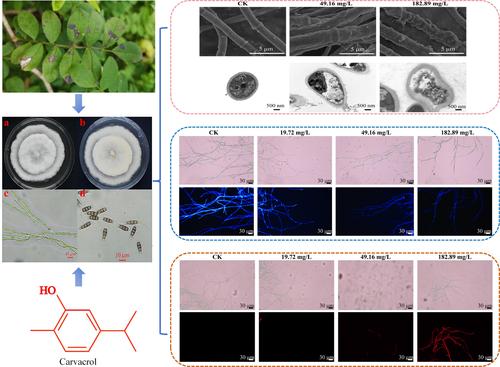Antifungal activities and underlying mechanisms of carvacrol against Neopestalotiopsis saprophytica causing leaf brown spot in Rosa roxburghii
Abstract
BACKGROUND
Rosa roxburghii produces a distinctive edible fruit renowned for its high vitamin C content and medicinal properties. Leaf brown spot is a newly identified fungal disease in R. roxburghii, causing considerable production losses in southwest China.
RESULTS
In this study, the pathogenic fungus causing brown spot in R. roxburghii was identified as Neopestalotiopsis saprophytica (CXCHB-2). Carvacrol, among seven selected phytocompounds, demonstrated strong antifungal activity against N. saprophytica with a 50% effective concentration (EC50) of 19.72 mg L−1. The mechanisms underlying the antifungal activity of carvacrol against N. saprophytica were investigated, and it showed that carvacrol disrupted N. saprophytica mycelium growth by inhibiting mycelial matrix, and compromising cell wall and membrane integrity. Moreover, the in vivo antifungal assays confirmed that carvacrol could inhibit the growth of N. saprophytica in R. roxburghii leaves with excellent therapeutic and protective effects (76.61% and 70.63%, respectively). Further investigations indicated that this phytocompound induced the upregulation of 24 differentially expressed genes related to the leaf hormone signal transduction of R. roxburghii, enhancing its resistance to N. saprophytica.
CONCLUSION
Carvacrol exhibited potent antifungal activity against N. saprophytica, causing leaf brown spot in R. roxburghii by disrupting its cell walls and membranes. Moreover, carvacrol could enhance the resistance of R. roxburghii leaves to N. saprophytica. Findings of this study suggested that carvacrol may serve as a promising plant-derived fungicide for controlling leaf brown spot in R. roxburghii leaves, providing a serviceable reference for its application in the agroforestry system. © 2025 Society of Chemical Industry.





 求助内容:
求助内容: 应助结果提醒方式:
应助结果提醒方式:


